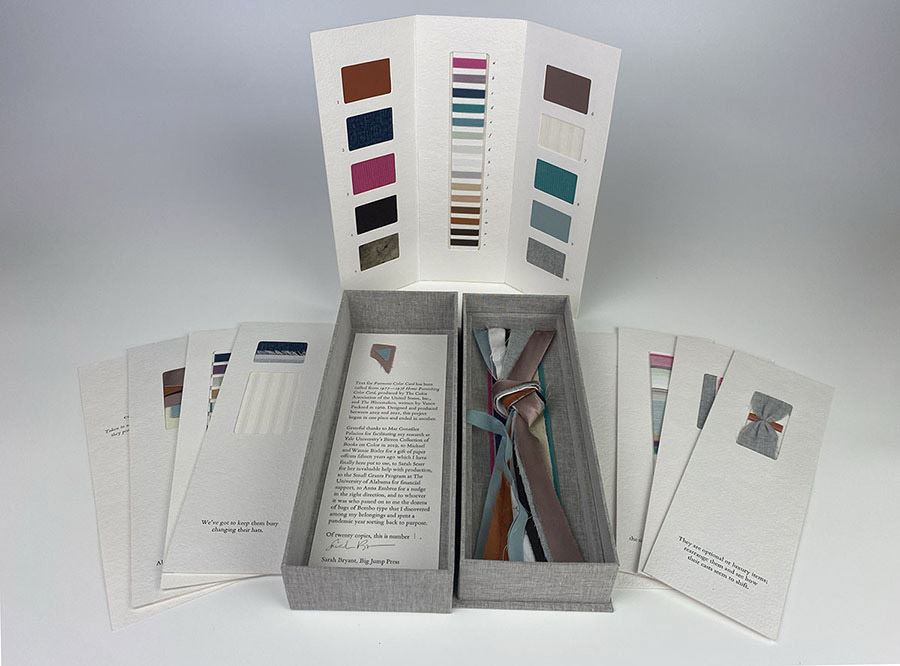Sarah:
In November of 2019 I traveled to Yale University in search of swatch books and color cards. The Faber Birren Collection of Books on Color is home to a comprehensive selection of texts, historical examples, artist books, and other resources, including eleven bankers’ boxes of textile samples and paint chips. Color systems on a large scale, and individual sample books on a smaller scale, are attempts to communicate color across distance, disciplines, and cultures. Our personal interactions with samples and swatches are less rational and more emotional, driven by touch and memory.
I was drawn in by the tactility of these samples, the beauty of their presentation, and the kinetic structures that protect them. I was also interested in the nuanced historical context for the production of these books. Like all manufactured objects, these color and textile samples were made in response to shifting technologies, economic factors, and complex national agendas. Color forecasting, the issuing of color cards in advance of a season, was an early form of planned obsolescence, and is still a major engine in the global economy. These color cards and sample books are part of our origin story as a landfill culture.

Fairmont Color Card
Early on in the design of Fairmont Color I planned to produce a series of color cards using my domestic surroundings. The pandemic interrupted the project and interfered with the foundational ideas for the book: what it means to be in a domestic space, how much (or how little) time I spent contemplating the colors and textiles that made up my private spaces. I shelved the project for a few months in the beginning of the pandemic, returning to it when I could find the time to engage in the repetitive tasks (thread winding and collage) that were necessary for its production.
Kathy:
When I saw this project, I was immediately struck by the connection that Sarah’s work was making with the work of feminist artists in the 1970s who were foregrounding the materials and processes of domesticity in their radical art. The painter Miriam Schapiro in particular created collage paintings that repurposed fabric swatches and traditional quilt patterns into large-scale wall pieces that re-stated women’s domestic work as an art form.

Miriam Schapiro, Nine Patch Gold, 1973, Courtesy Mills College Art Museum. (Gallery view, Possibilities: When artists' books were young, 2022, San Francisco Center for the Book, Kathleen Walkup, curator)
When Faith Ringgold began her experimentation with fabric and quilts, working alongside Willi Posey, her seamstress mother, to create stuffed dolls, masks and story quilts that told of the oppression of Black people, her art was dismissed as craft. One gallery refused to hang two of her masks with other art in the gallery. Ringgold withdrew the masks and instead wore them to the opening. [1]
Sarah’s work implicitly acknowledges this legacy while at the same time questioning how these intensely personal and familiar materials of her own domestic space contribute to the very twenty-first century challenges of social and environmental justice.
Sarah:
Thank you for those observations! I came to the use of fabric and textile organically through the research I was doing on color and industry (see Regina Lee Blaszczyk’s excellent book The Color Revolution). Once I had determined the course of the book and made the decision to use my clothes and bedding and primary materials, I found myself using my hands and body in unfamiliar ways. No longer tied to the press, I was engaged in hand skills that were outside of my experience but had a long history in connection with femininity and domesticity. Artists like Schapiro and Ringgold were certainly on my mind. I also found myself thinking a great deal about my mother, who for a time sewed all of her own clothes.
I believe that this book was also made possible by collaborative work that I have been engaged in since 2013 with Shiftlab Collective. Working with other artists, watching their process and material choices, designing our projects collectively all have expanded my independent work. Katie Baldwin and Denise Bookwalter in particular are printmakers and book artists who incorporate textile and quilting into their process. Spending time in their company certainly has expanded my ideas about materials and the nature of the book.
[1] Auther, Elissa. String Felt Thread: The hierarchy of art and craft in American art. Minneapolis, MN: University of Minnesota Press, 2010.
Sarah Bryant produces artist books and prints under the name Big Jump Press. She is currently an assistant professor at The University of Alabama where she teaches for the MFA Book Arts Program. Her work can be found in many collections, including The Library of Congress, The New York Public Library, and The Yale Arts Library.
Kathleen Walkup is Professor Emerita at Mills College. Her research interests focus on the history of women and printing and conceptual practice in artists’ books. The catalogue for the exhibition she curated, Possibilities: When artists’ books were young, is available through the San Francisco Center for the Book website. She is a founding director of the College Book Art Association.

